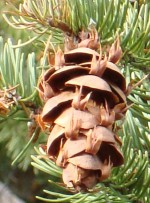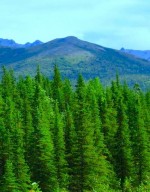 The Pine Family includes the gymnosperms that are most familiar to everyone; pine, spruce, fir, and hemlock plus the not so familiar larch. It also includes Douglas fir which is not a true fir. The term gymnosperm means naked seed and refers to the fact that the seeds are exposed rather than enclosed in a fruit as is typical of the flowering plants. The Pine Family are commercially valuable for their lumber, pulp, and nuts, and are grown as Christmas trees and for their ornamental use in the garden. The nuts from pinion pines are found in grocery stores but the nuts of all members of the Pine Family are edible and have been a source of food historically. There are 220 species in 10 genera world wide. Other gymnosperms that are not in the Pine Family include cypress, yew, and redwood.
The Pine Family includes the gymnosperms that are most familiar to everyone; pine, spruce, fir, and hemlock plus the not so familiar larch. It also includes Douglas fir which is not a true fir. The term gymnosperm means naked seed and refers to the fact that the seeds are exposed rather than enclosed in a fruit as is typical of the flowering plants. The Pine Family are commercially valuable for their lumber, pulp, and nuts, and are grown as Christmas trees and for their ornamental use in the garden. The nuts from pinion pines are found in grocery stores but the nuts of all members of the Pine Family are edible and have been a source of food historically. There are 220 species in 10 genera world wide. Other gymnosperms that are not in the Pine Family include cypress, yew, and redwood.
The distinguishing characteristics of the Pine Family are:
 Leaves are needle-like. The needles are either alternate or in alternate bundles.
Leaves are needle-like. The needles are either alternate or in alternate bundles.
 Seeds are borne on the surface of scales on woody female cones. The scales are at first tightly closed but open with maturity allowing the wind to disperse the seeds.
Seeds are borne on the surface of scales on woody female cones. The scales are at first tightly closed but open with maturity allowing the wind to disperse the seeds.
 Resinous. Aromatic scent can be noted when wood or needles are broken or cut.
Resinous. Aromatic scent can be noted when wood or needles are broken or cut.
Members of the family are divided into six major genera that can be distinguished as follows:
Larch and Tamarack (Larix) – deciduous
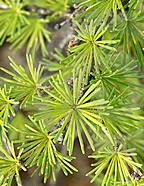
Pine (Pinus) – needles in bundles of 3,4, or 5
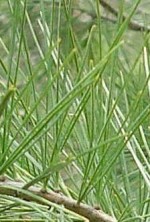
Spruce (Picea) – needles sharp, stiff and square in cross section, not in bundles
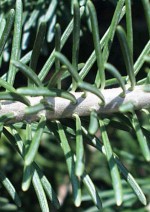
Fir (Abies) – Needles flat and not in bundles, cones upright
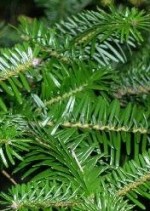
Hemlock (Tsuga) – Needles flat and not in bundles, cones small and pendulous
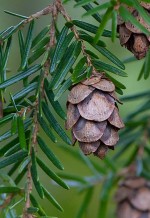
Douglas Fir (Pseudotsuga) Needles flat and not in bundles; cones large and with distinctive bracts. If the tree does not have any cones, you may have a hard time identifying it because the needles are similar to those of true fir.
